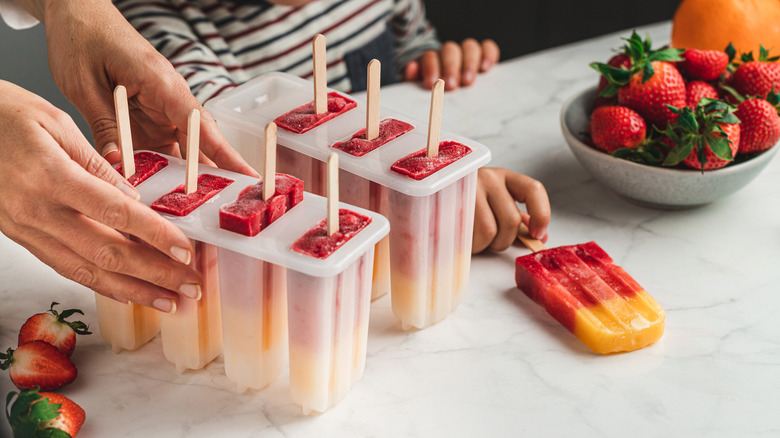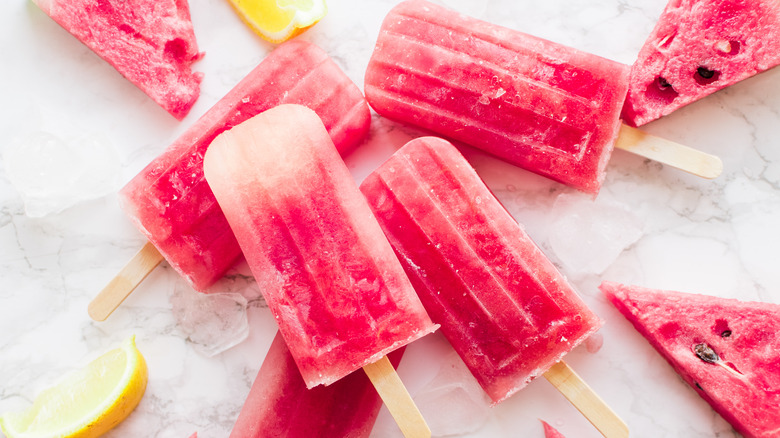No Popsicle Tray? Just Use Some Shot Glasses
Making popsicles isn't rocket science. Just get your beverage of choice — orange juice, Hawaiian Punch, or your favorite soda — and pour it into an ice cube tray or paper cup. Cover the tray or cup with plastic wrap or tinfoil and poke your popsicle stick of choice — a toothpick or skinny metal spoon, for example — through the wrap. Freeze the tray or cup and then pop out your solidified homemade popsicle. Again, very simple stuff.
But what happens if you don't have any paper cups, or maybe your ice cube tray is still full of semi-frozen water? Fortunately, you don't need anything elaborate to make homemade popsicles. If you have shot glasses sitting in your cabinet, they'll work perfectly fine. They don't have to be fancy or expensive; as long as they can hold a beverage without leaking, they'll work great. Simply follow the same steps as you would with your ice cube tray or paper cup. In an hour or so, you'll have tiny perfectly shaped popsicles ideal for any summer barbecue or as a refreshing treat.
There is, however, one catch to this method. Unlike an ice cube tray or paper cup, you can't exactly toss your shot glasses in the freezer and forget about them for a few hours. Doing so may cause you to ruin your otherwise perfectly good shot glasses.
Leaving your shot glasses in the freezer can cause them to crack
It is, of course, entirely possible to freeze glass. Putting a shot glass or a mug into your freezer until it gets frosty isn't going to hurt anyone and has the added benefit of making your drink colder without needing ice. But just because you can freeze glass doesn't mean it will be incredibly resilient without care.
Assume you're making popsicles using your shot glasses but forget them in the freezer. As the glass sits in the freezer, the liquid inside will slowly expand during freezing. This expanding liquid and the resulting pressure press against the glass, causing tiny cracks that grow over time. Glasses can also break because of thermal shock, which is when the temperature of an object changes very rapidly. If a glass suddenly gets incredibly cold, the surface will begin to crack, similar to how a pizza stone may crack in the oven's intense heat.
Paradoxically, how can you freeze glass to make popsicles if the glass can crack or shatter because of temperature changes? The answer to this problem lies not within the glass itself but with a careful focus on how much time the glass is actually in the freezer.
Remove the popsicles right when they begin to freeze
While it's entirely possible to freeze glass without it cracking or breaking, the trick to doing so requires you to pay close attention to when the liquid begins to freeze. This usually occurs about an hour into the freezing process; the beverage will begin to solidify, and the glass will have that trademark frosty exterior.
But when you pop out the chilled beverage, it will only be moderately frozen — enough to keep its shape. To finish the freezing process, take a large plastic sandwich bag and put your popsicles inside of it (making sure to provide as much room as possible between them) before sealing it. Place the bag of popsicles back in the freezer and allow them to finish freezing. This way, the glasses aren't exposed to the extreme cold for too long and, as a bonus, the bag makes it easier to pull out individual popsicles.
If you pay close attention to how long your glasses have been in the freezer, shot glasses will suffice as a popsicle mold, and you can make homemade treats without any problems.


